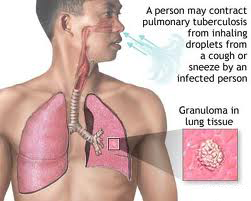TB Symptoms and Treatment
The term ‘tuberculosis’ (or TB) has been derived from the name of its causative bacterium Tubercles bacillus. Tubercles bacillus is a strain of the bacterium Mycobacterium tuberculosis. Tuberculosis is a very deadly and a serious infection.
TB has been found to show fatal results in about 50% of its patients, if left untreated. About one-third of the total worldwide population has been found infected with TB. It is also estimated that every second at least 1 person is infected with TB. The symptoms of Tb are common in Asian and African countries whereas the count is quite less in the US.

The immune system attacks the TB bacteria within 2-8 weeks after a person is being infected. In some cases the bacteria can die and the infection can clear completely, but in others the bacteria can stay in an inactive state in the body and cause no TB symptoms. In still other cases the infection can develop in to active TB.
Symptoms of TB
Pulmonary tuberculosis is the most common form and coughing is often a common and only initial indication of tuberculosis.
Other signs and symptoms of active tuberculosis includes –
- Severe cough which lasts for three weeks or longer which produce bloody or discolored sputum
- Night sweats
- Slight fever
- Chills
- Fatigue and weakness
- Pain in the chest
- Loss of appetite
- Unintentional weight loss
TB treatment
- Diagnosis of TB signs and symptoms is usually done by taking samples of sputum or fluids from the lungs or other body parts.
- Modern medication for TB has proved to be very effective TB cures in TB treatment.
- Active TB treatment consists of multiple antibiotics combinations Medication for TB includes drugs combinations to prevent patients suffering from TB becoming resistant to treatment.
- These medications have to be continued for a period ranging from a minimum of six months to a year. Medication for TB cures take time to show their effectiveness.
- The medications for TB treatment are effective only if doses are not missed in between. Any reduction in, or discontinuation of the prescribed dosage can prolong or worsen the symptoms and can cause complications in some cases.
- Nonetheless, besides being viewed as TB cures, these medications carry some side effects.
Some side effects of TB medications that can include:
- Jaundice
- Abdominal pain tenderness or soreness
- Nausea Fever for 3 days or of a longer duration
- Dark colored urine
- Vomiting
- Blurred vision
The most important step is to find, isolate and treat all disease carriers until they are no longer an infective risk to others.
It is always advisable not to get too close to people who are coughing; equally, people with a cough should be aware of those around them and try not to cough near them. Pregnant women with TB must be treated urgently as the disease may progress rapidly with high risk to both mother and baby.








.webp)